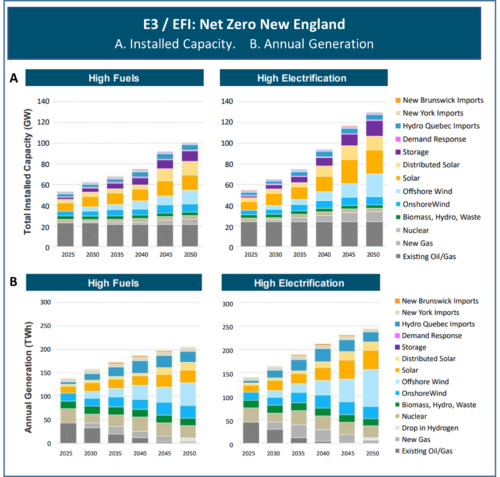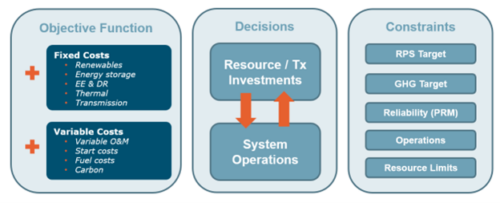RESOLVE is an electricity resource planning model that identifies optimal long-term electric generation and transmission investments subject to reliability, policy, and technical constraints. Designed in 2014 to assess the investment needs of systems seeking to integrate large quantities of variable renewable resources, RESOLVE identifies optimal portfolios of renewable and conventional energy resources through capacity expansion and production simulation modeling. Optimal investment plans account for the capital costs of new resources, the variable costs of reliably operating the grid, and additional values such as environmental attributes. RESOLVE has been used to support resource planning and valuation for dozens of clients across North America.
Historically, resource planning focused on the balance between capital-intensive resources with low operating costs (baseload resources) and low-capital cost resources with higher operating costs (peaking resources). In this traditional resource planning paradigm, simple modeling approaches using load-duration curves were adequate for determining optimal investment plans for a given load forecast. In decarbonizing power systems, variable renewables and battery storage resources are increasingly likely to be the new energy and capacity investments of choice given evolving resource costs and policy targets. Evaluating investments in these resources requires an understanding of system dispatch, with chronological simulation needed to capture constraints on resource availability and operations.
RESOLVE co-optimizes investments and operations to minimize total system costs, subject to constraints such as clean energy standard targets, greenhouse gas emissions targets, resource adequacy requirements and operational reliability parameters. In today’s environment, capacity expansion modeling is a crucial tool for evaluating investment plans with high levels of renewables and energy storage for which the vast majority of costs are related to upfront capital investment.
Many electric-sector planning studies have used or are currently using this model:
- Hawaiian Electric Company’s used RESOLVE to support their 2023 Integrated Grid Plan: A pathway to a clean energy future (IGP). For this study, E3 supported Hawaiian Electric and the IGP by developing and maintaining RESOLVE electric-sector planning models for the islands of Oʻahu, Hawaiʻi, Maui, Lānaʻi, and Molokaʻi. RESOLVE was used to model resource portfolios for the IGP, and is also being used to evaluate proposals for energy resources submitted in response to Hawaiian Electric solicitations.
- The California Public Utilities Commission uses RESOLVE in the Integrated Resource Planning process (IRP). RESOLVE is used to develop system-wide resource plans for the CAISO that meet state policy goals and GHG emissions reduction targets through the optimization of the renewable portfolio and integration solutions. These plans inform utility resource procurement as well as the CAISO Transmission Planning Process (TPP).
- E3 supports the New York State Energy Research and Development Authority (NYSERDA) in analysis to inform the New York Climate Action Council’s “Scoping Plan,” including modeling scenarios showing how New York could achieve carbon neutrality as outlined in the Climate Leadership and Community Protection Act (the Climate Act). E3’s work includes detailed power sector modeling of the Climate Act electricity system targets, including goals of 70% emissions reduction by 2030 and 100% emissions reduction by 2040 as well as technology-specific targets such as a target of 9 GW offshore wind development. This work was published in the Technical Supplement to the Draft Scoping Plan (Appendix G).
- The Calpine Corporation engaged E3 to study electricity sector resource adequacy requirements under long-term economy-wide decarbonization in the New England states (MA, CT, RI, NH, VT, ME). E3 completed the Net Zero New England study in conjunction with the Ernest Moniz’s Energy Futures Initiative (EFI) and a regional stakeholder advisory group. E3 used RESOLVE and RECAP to evaluate future resource portfolios for New England under a range of assumptions, each meeting economy-wide net zero carbon emissions goals. The study found that achieving electricity sector decarbonization while meeting additional load growth from electrification requires a significant build-out of solar, wind (onshore and offshore), battery storage, and additional firm generating capacity to maintain acceptable reliability during periods of low wind and solar generation.


All Tools


